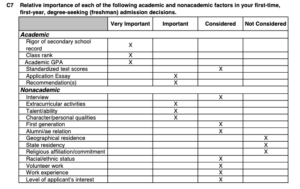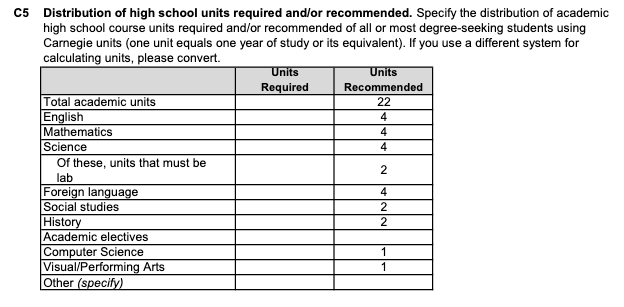Why You Really Need to Check Out the College Common Data Set
Last Updated on March 29, 2023 by Jill Schwitzgebel
What if I told you there was information readily available online that would go a long way in helping your student more accurately assess their chance of admission at a particular college? I’m not talking about those threads that high school students do on some forums called “Chance Me for Admissions at XYZ University.” I’m talking about the college Common Data Set (CDS), which, as the name suggests, is literally data about the college.
The part that makes it “Common” is that each college completes the same standardized questionnaire from the Common Data Set Initiative. This collaboration is to try to improve both the quality and accuracy of data provided to potential college applicants. And to me, the biggest benefit is that even though there is a LOT of information there, it allows you to compare apples to apples among colleges. To find the CDS of a college your student is interested in, simply search the name of the college and “College Data Set” and it should pop right up. There is usually a link on each college’s website, but sometimes, it is difficult to find.
To me, the college’s Common Data Set is probably THE most important resource that families should consult once a student has begun to narrow down their college list.
Factors in Admission
While the CDS is incredibly useful for finding out ALL kinds of information, like acceptance rates, average test scores and GPAs of recently admitted students, it also allows students to access other less widely known, but also important, information. There is a chart, in section C7, which contains incredibly valuable information for potential applicants. This chart will tell you every factor that the college will consider in admission, academic and non-academic. Just as importantly, it will tell how they weight each category. Presume that it will be pretty standard that GPA and a rigorous curriculum will be considered “Very Important” by most every college. And presume that at the most selective colleges, that just about every academic category will be considered to be very important.
Here are two examples of the C7 chart to compare:


In these examples, both colleges consider the rigor of secondary school record and GPA to be “Very Important”, but Occidental will give greater weight to the essay, and Northwestern gives more consideration to class rank. And you can see that both of the colleges each list several non-academic factors as just as important as some academic qualities. Both consider extracurricular activities and character just as important as recommendations. Importantly, and this is something often missed by students, both schools will also at least “consider” the level of interest that an applicant has shown in the college.
Course Requirements
Another important section of the CDS tells you what courses students need to have completed in high school, to be competitive for admission. This can be critical information for students planning their senior class schedule.
Here is an example, from Emory University:

Increasingly, colleges don’t list the number of courses (units) required. This gives them flexibility in admissions, depending on the applicant’s other qualities. But, the more competitive the college, the more “required” those units are. I would not anticipate a student with only three units of science getting admitted to a selective college, without some other major advantage. So, when looking at these charts, students should consider the recommendations to be minimum requirements for admission.
Financial Aid
Section H of the CDS is all about numbers. Here, you can learn all about how much financial aid the college gives, and how they give it. It will tell you how many students applied for aid, how many were deemed to have financial need and what percentage of that need the college has met in the past. You can find out what the average scholarship and grant amount is and how much the average student loan award is. Now, all of this information must be put into perspective, because of course, you don’t know how your family compares financially to other applicants, but at least you get a picture here.
Using The Common Data Set
In another section of the CDS, you can find additional helpful information like what a college’s waitlist movement has looked like in the past, or how often those deferred from early admission rounds get admitted in the spring. This can help students who are trying to make decisions about whether to accept a spot on a waitlist, or temper expectations about a deferral. If diversity is important to your student, that information is readily available, too.
I don’t consider the Common Data Set to be the very first resource that families should look at when searching for colleges. Remember, the data will change year to year, usually just slightly. But, I do believe that it’s a valuable resource that families need to consult during the next phase of the college application process, prior to applying, as it’s the best resource for the most accurate information. And, I think that the deeper understanding of both the academic and nonacademic factors that colleges consider is one of the most beneficial uses of the CDS.
You may also like: The Best Online Resources for College Admission








